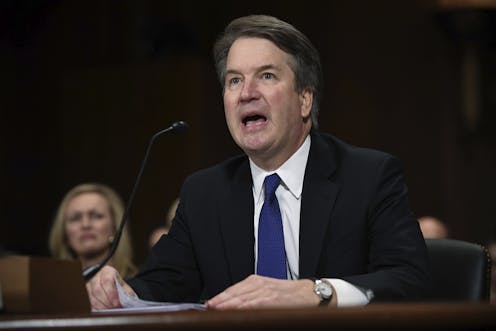Interruptions at Supreme Court confirmation hearings have been rising since the 1980s
- Written by Paul M. Collins, Jr., Professor and Director of Legal Studies, University of Massachusetts Amherst

Depending on who you ask, the American people saw very different things in the riveting testimony before the Senate Judiciary Committee on Supreme Court nominee Brett Kavanaugh.
To some[1], Kavanaugh’s behavior was the self-indulgent temper tantrum of an angry and entitled man. To others[2], it was the understandable – even laudable – reaction of a man pushed too far, forced to defend his honor.
There are no obvious ways to bridge this perception gap. The meaning of Kavanaugh’s display, it appears, is in the eye of the beholder. To us, as legal scholars, it was a stunning display from a sitting federal judge. We have, for more than a decade, studied Supreme Court confirmation hearings in minute detail, and we have never seen anything like it. Even Clarence Thomas’s striking metaphor in 1991, denouncing his confirmation hearing a “high-tech lynching,”[3] did not openly invoke such raw partisanship or vengeful threats such as Kavanaugh’s “what goes around comes around.”[4]
But, as scholars of the confirmation process, we aim to measure what is measurable, in the hope that data can inform our more subjective perceptions of politics. And one measurable feature of Kavanaugh’s testimony is the striking number of times he interrupted[5] the[6] senators[7] to challenge their comments or force his own point. Here, the historical record can shed some light.
There is a great deal of research on the power dynamics of interruptions. Interrupting another speaker is a way of wresting authority and conversational control[8] away from the original speaker. Even when an interruption is intended to be helpful, the act of interrupting communicates dominance and confidence. This can contribute to the silencing of women and minorities[9].
Additionally, all interruptions are not viewed equally. Numerous studies have shown that female interrupters tend to be seen more negatively than male interrupters. For example, a study out this year[10] from Stanford scholar Katherine Hilton found that that perception is itself gendered. Male listeners were more likely to view a female interrupter as ruder, less friendly and less intelligent than a male one. Notably, this study involved cases in which the interrupting speaker, like Kavanaugh, raised his voice or used the interruption to change the subject.
That may explain why Republican senators and voters, who are disproportionately[11] male[12], see Kavanaugh’s pattern of aggressive interruptions in a more sympathetic light[13]. It also puts in context the seeming contradiction of Kavanaugh’s vocal indignation that the (often female) senator who he had interrupted moments before would not let him finish the point he had interrupted her to make.
This is a familiar pattern. In our paper[14], presented last month with Christina L. Boyd at the American Political Science Association Annual Meeting in Boston, we examined interruptions at confirmation hearings. To do this, we investigated every question asked and every answer given at every open, transcribed Supreme Court confirmation hearing from 1939 to 2010 – a total of more than 31,000 statements.
Data shows that the rate of interruptions at the hearings is increasing. The interruptions themselves echo and amplify racial, gender and partisan divides.
Some earlier hearings were marked by a relatively high percentage of interruptions – most notably the Robert Jackson and Antonin Scalia hearings in 1941 and 1986, respectively. But the steady upward trend really began with the nominations of Clarence Thomas and Ruth Bader Ginsburg: a member of a racial minority and a woman.
Female nominees are particularly affected, interrupted almost twice as frequently as male nominees. This pattern is amplified by partisan opposition between the speaker and the interrupter.
Because three of the four female nominees have been appointed by Democratic presidents, and because there has to date been no female Republican senator on the Judiciary Committee, this also means that most of these interruptions have been Republican senators interrupting the female nominees of Democratic presidents.
We have found in our research that Supreme Court confirmation hearings both reflect and amplify societal perceptions of gender norms and biases. This sheds light on the very different lenses through which a deeply polarized nation viewed what happened during the hearing featuring Judge Kavanaugh and Christine Blasey Ford. For many (obviously not all) women, it was the dramatic culmination of a power dynamic they see played out both in their own lives and in prior confirmation hearings. For others – most obviously the male Republican senators sitting in the hearing room – that dynamic was likely less visible, and almost certainly less salient.
The gender divide between the two major political parties is large and growing[15], and support for the Supreme Court itself is increasingly fracturing on that basis[16]. The nation’s disparate reactions to Kavanaugh’s testimony vividly illustrate the risk that division poses to Americans’ ability to understand each other’s perspective, much less find common ground.
References
- ^ To some (www.washingtonpost.com)
- ^ To others (www.wsj.com)
- ^ “high-tech lynching,” (www.vox.com)
- ^ “what goes around comes around.” (www.nytimes.com)
- ^ interrupted (www.kansascity.com)
- ^ the (www.washingtonpost.com)
- ^ senators (psmag.com)
- ^ wresting authority and conversational control (doi.org)
- ^ the silencing of women and minorities (doi.org)
- ^ For example, a study out this year (news.stanford.edu)
- ^ disproportionately (www.cawp.rutgers.edu)
- ^ male (www.people-press.org)
- ^ more sympathetic light (time.com)
- ^ In our paper (cdn.theconversation.com)
- ^ large and growing (www.vox.com)
- ^ increasingly fracturing on that basis (news.gallup.com)
Authors: Paul M. Collins, Jr., Professor and Director of Legal Studies, University of Massachusetts Amherst


